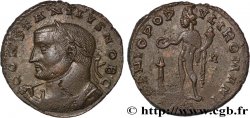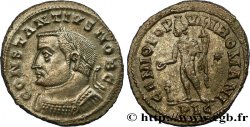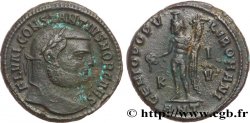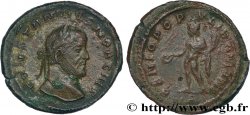E-auction 101-52973 - brm_266759 - CONSTANTIUS I Follis ou nummus
You must signin and be an approved bidder to bid, LOGIN TO BID. Accounts are subject to approval and the approval process takes place within 48 hours. Do not wait until the day a sale closes to register. Clicking on « bid » constitutes acceptance of the terms of use of cgb.fr private e-auctions.
Bids must be placed in whole Euro amounts only. The sale will start closing at the time stated on the item description; any bids received at the site after the closing time will not be executed. Transmission times may vary and bids could be rejected if you wait until the last second. For further information ckeck the E-auctions F.A.Q.
NO BUYER'S FEE.
NO BUYER'S FEE.
| Estimate : | 380 € |
| Price : | 153 € |
| Maximum bid : | 155 € |
| End of the sale : | 23 March 2015 15:26:30 |
| bidders : | 6 bidders |
Type : Follis ou nummus
Date: 300-302
Date: 300 - mi 304
Mint name / Town : Lyon
Metal : copper
Diameter : 29 mm
Orientation dies : 6 h.
Weight : 11,99 g.
Rarity : R2
Officine: 1re
Coments on the condition:
Exemplaire à l’usure régulière sur un flan large et ovale, bien centré. Beau portrait inhabituel de Constance Chlore. Frappe faible au revers. Jolie patine marron noir avec des reflets métalliques
Obverse
Obverse legend : CONSTANTIVS NOB CAES.
Obverse description : Buste lauré consulaire de Constance Ier césar à gauche, vu de trois quarts en avant, tenant le scipio (H*2).
Obverse translation : “Constantius Nobilissimus Cæsar”, (Constance très noble césar).
Reverse
Reverse legend : GENIO POP-VLI ROMANI/ (AUTEL)|A// PLG.
Reverse description : Genius (Génie) debout à gauche, coiffé du modius, le manteau sur l'épaule gauche, tenant une patère de la main droite et une corne d'abondance de la main gauche.
Reverse translation : “Genio Populi Romani”, (Au Génie du Peuple romain).
Commentary
Poids lourd. Rubans convergents : rubans descendant verticalement le long de la nuque ou légèrement incurvés vers l’arrière (type 3). Buste consulaire richement décoré avec la “toga palmata” et la “toga picta”.








 Report a mistake
Report a mistake Print the page
Print the page Share my selection
Share my selection Ask a question
Ask a question Consign / sell
Consign / sell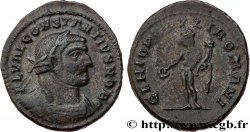
 Full data
Full data